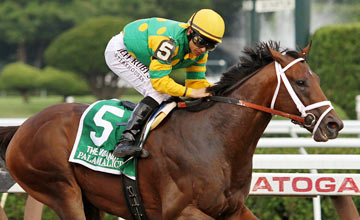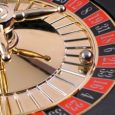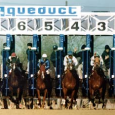
Palace Malice (via The Racing Post)
One of the ways that my speed rations are different than traditional pace figures is that they measure energy distribution, rather than pure speed. Of course, there are disadvantages to this approach, but the biggest positive is that the numbers are both relative and timeless.
In his brilliant, albeit (very) short, book “Race Is Pace,” author Huey Mahl notes that the “average” thoroughbred, in reasonable racing condition, can traverse a quarter-mile in 28 seconds “all day” long.
“It’s when we ask our horse to run faster than 28-second quarters that we start to put demands on his physical endurance,” Mahl explained. “And the faster we ask him to go, the less distance he can cover before muscle fatigue sets in and he shortens stride approaching the point of total exhaustion.”
My speed rations attempt to measure and quantify these demands on physical endurance that Mahl talked about — and I am always on the lookout for extraordinary performances… as was the case on June 8, 2013:
(Click on image to enlarge.)
In the Kentucky Derby, Palace Malice recorded an insanely taxing -15 early speed ration (ESR) — the second-lowest (best) figure in the history of that storied race (behind Groovy’s -16 ESR in the 1986 Run for the Roses).
Yet, unlike Groovy, Palace Malice didn’t finish last on the first Saturday in May. Frankly, he didn’t run badly at all, checking in 12th, beaten just 13 ½ lengths by the late-running Orb, who after getting such a dream pace setup, never won again, wrapping up his career with a dead-last finish in the Jockey Club Gold Cup.
A performance like that — in a Grade I event at a classic distance — marked Palace Malice as a horse to reckon with and I was excited when he showed up in the Belmont Stakes five weeks later.
Folks, who had obviously never read Mahl’s book, made Orb the 2-1 favorite in the third jewel of the Triple Crown, while Palace Malice was dismissed at 13-1. Of course, Palace Malice won (if he hadn’t, this example would have been rather pointless), recording a solid — but far more reasonable — ESR of -9 in the process.
Another thing to look for with steeds that expended an inordinate amount of early energy last time is a drop in class, e.g. today’s purse is at least a third (33 percent) lower than the purse in horse’s prior start.
According to an impromptu database study that I did, such animals produce a 1.30 impact value (IV) and, more importantly, show a positive return on investment.
As luck would have it, there is just such a horse running at Mahoning Valley Race Course on Wednesday, Dec. 2:

(Click on image to enlarge.)
After racing primarily in short sprints for her entire career, Amazing Summation tried a route for the first time at Churchill Downs on Nov. 18 and earned a ridiculous -22 ESR. On Wednesday, she drops back in class and I think the added-distance run could do her some good, despite the fact that she backed up like a toilet at a chili cook-off in that race.





